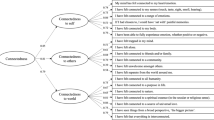Abstract
Research has shown that the perceptions that form the cognitive representation of an illness (illness representation) are fundamental to how persons cope with illness. This study examined the relationship of illness representation of HIV with self-care behavior and health outcomes. Data were collected at 16 sites in the United States, Taiwan, Norway, Puerto Rico and Colombia via survey. HIV seropositive participants (n = 1,217, 31% female, 38% African-American/Black, 10% Asian/Pacific Islander and 26% White/Anglo) completed measures of illness representation based on the commonly accepted five-component structure: identity, time-line, consequences, cause, and cure/controllability (Weinman et al. 1996, Psychology and Health, 11, 431–445). Linear regression analyses were conducted to investigate relationships among illness representation, self-care behaviors and quality-of-life outcomes. Components of illness representation were associated with self-care and health outcomes, indicating that the cognitive representation of HIV has consequences for effective illness management. For example, perception that there is little that can be done to control HIV was significantly associated with fewer and less effective self-care activities (F = 12.86, P < .001) and poorer health function in the domain of quality-of-life (F = 13.89, P < .001). The concept of illness representation provides a useful framework for understanding HIV symptom management and may be useful in directing development of effective patient-centered interventions.
Similar content being viewed by others
References
Alonzo, A. A., & Reynolds, N. R. (1998). The structure of emotions during acute myocardial infarction: A model of coping. Social Science & Medicine, 46, 1099–1110.
Cameron, L. D., & Leventhal, H. (2003). The self-regulation of health and illness behaviour. New York: Routledge.
Chou, F. Y., Holzemer, W. L., Portillo, C. J., & Slaughter, R. (2004). Self-care strategies and sources of information for HIV/AIDS symptom management. Nursing Research, 53, 332–339.
Clark, N. M., Gong, M., & Kaciroti, N. (2001). A model of self-regulation for control of chronic disease. Health Education and Behavior, 28(6), 769–782.
Cleary, P. D., Fowler, F. J. Jr., Weissman, J., Massagli, M. P., Wilson, I., Seage, G. R. 3rd, Gatsonis, C., & Epstein, A. (1993). Health-related quality of life in persons with acquired immune deficiency syndrome. Medical Care, 31, 569–580.
Corless, I. B., Bunch, E. H., Kemppainen, J. K., Holzemer, W. L., Nokes, K. M., Eller, L. S., Portillo, C. J., Butensky, E., Nicholas, P. K., Bain, C. A., Davis, S., Kirksey, K. M., & Chou, F. Y. (2002). Self-care for fatigue in patients with HIV. Oncology Nursing Forum, 29, E60–E69.
Holmes, W. C., & Shea, J. A. (1998). A new HIV/AIDS-targeted quality of life (HAT-QoL) instrument: Development, reliability, and validity. Medical Care, 36, 138–154.
Holmes, W. C., & Shea, J. A. (1999). Two approaches to measuring quality of life in the HIV/AIDS population: HAT-QoL and MOS-HIV. Quality of Life Research, 8(6), 515–527.
Holzemer, W. L. (2002). HIV and AIDS: The symptom experience. What cell counts and viral loads won’t tell you. American Journal of Nursing, 102, 48–52.
Holzemer, W. L., Hudson, A., Kirksey, K. M., Hamilton, M. J., & Bakken, S. (2001). The revised sign and symptom check-list for HIV (SSC-HIVrev). Journal of the Association of Nurses in AIDS Care, 12, 60–70.
Kemppainen, J. K., Holzemer, W. L., Nokes, K., Eller, L. S., Corless, I. B., Bunch, E. H., Kirksey, K. M., Goodroad, B. K., Portillo, C. J., & Chou, F. Y. (2003). Self-care management of anxiety and fear in HIV disease. Journal of the Association of Nurses in AIDS Care, 14, 21–29.
Leventhal, H., Benyamini, Y., Brownlee, S., Diefenbach, M., Leventhal, E. A., Patrick Miller, L., & Robitaille, C. (1997). Illness representations: Theoretical Foundations. In K. J. Petrie & J. A. Weinman (Eds.), Perceptions of health and illness: Current research and applications. Singapore: Harwood Academic Publishers.
Leventhal, H. L., Nerenz, D. R., & Steele, D. J. (1984). Illness representations and coping with health threats. In A. Baum, S. E. Taylor, & J. E. Singer (Eds.), Handbook of psychology and health. Hillsdale, NJ: Lawrence Erlbaum.
Nicholas, P. K., Kemppainen, J. K., Holzemer, W. L., Nokes, K. M., Eller, L. S., Corless, I. B., Bunch, E. H., Bain, C. A., Kirksey, K. M., Davis, S. M., & Goodroad, B. K. (2002). Self-care management for neuropathy in HIV disease. AIDS Care, 14, 763–771.
Petrie, K. J., & Weinman, J. (1997). Perceptions of health and illness: Current research and applications. Amsterdam: Harwood Academic Publishers.
Reynolds, N., & Alonzo A. A. (2000). Self-regulation theory: Review and analysis. In V. Rice (Ed.), Handbook of stress, coping and health. Thousand Oaks: Sage.
Reynolds, N. R. (2003). The problem of antiretroviral adherence: A self-regulatory model for intervention. AIDS Care, 15, 117–124.
Strauss, A. (1990). A trajectory model for reorganizing the health care system, perspectives in nursing 1989–1991. New York: National League for Nursing.
Strauss, A. L., Corbin, J., Fagerhaugh, S., Glaser, B. G., Maines, D., Suczek, B., & Wiener, C.L. (1984). Chronic illness and the quality of life (2 ed.). St. Louis: Mosby.
Tsai, Y. F., Hsiung, P. C., & Holzemer, W. L. (2003). Validation of a Chinese version of the sign and symptom checklist for persons with HIV diseases. Journal of Pain and Symptom Management, 25, 363–368.
Weinman, J., Petrie, K. J., Moss-Morris, R., & Horne. R. (1996). The Illness Perception Questionnaire: A new method for assessing the cognitive representation of illness. Psychology and Health, 11, 431–445.
Acknowledgments
Support: U.S. NIH, NIAID, AIDS Clinical Trials Group (U01AI68636), The Ohio State University (U01AI069474), NIH, NINR (R01 NR05108) nrr. We wish to thank the study volunteers for their contribution to this project and Christopher Holloman, PhD, Director Statistical Consulting Service, The Ohio State University, for his consultation.
Author information
Authors and Affiliations
Corresponding author
Rights and permissions
About this article
Cite this article
Reynolds, N.R., Sanzero Eller, L., Nicholas, P.K. et al. HIV Illness Representation as a Predictor of Self-care Management and Health Outcomes: A Multi-site, Cross-cultural Study. AIDS Behav 13, 258–267 (2009). https://doi.org/10.1007/s10461-007-9297-5
Received:
Accepted:
Published:
Issue Date:
DOI: https://doi.org/10.1007/s10461-007-9297-5



